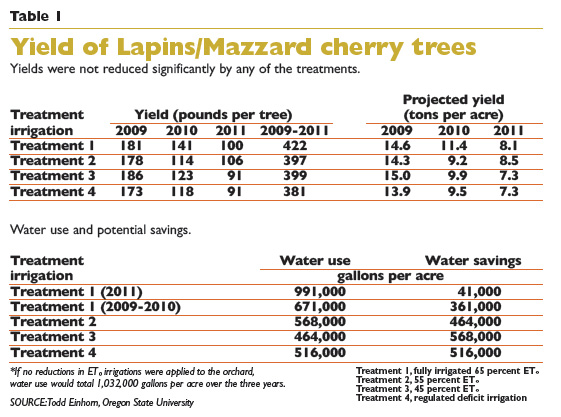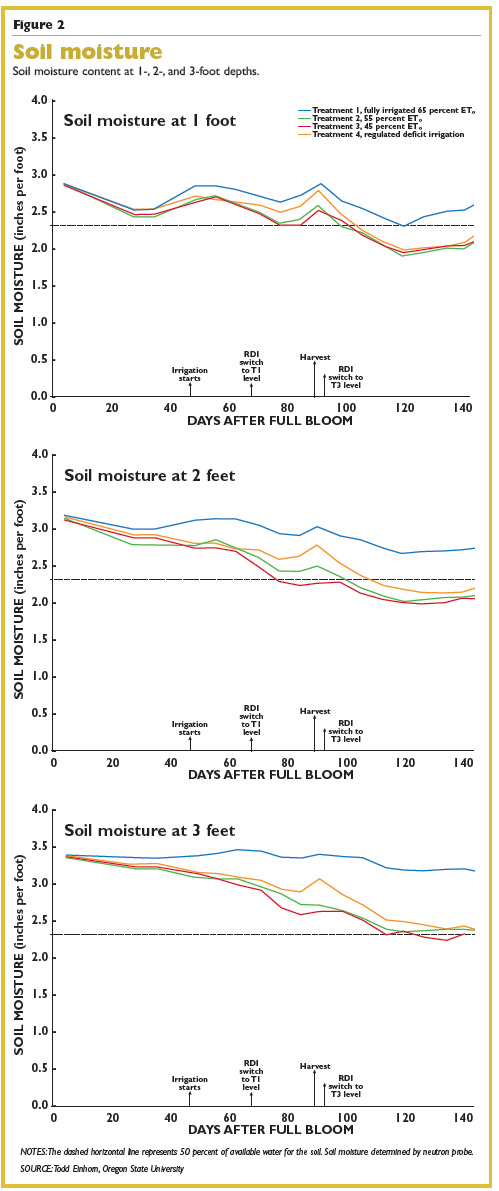Lapins fruit quality was excellent in all three years of the deficit irrigation study.
Todd Einhorn
 A significant portion of sweet cherry acreage throughout California and the Pacific Northwest faces water challenges. Sustainable irrigation practices need to be developed to efficiently manage limited water supplies. The most readily available information for scheduling irrigations is reference evapotranspiration (ETº). High temperatures, low humidity, and/or wind drive plant water use, and, hence, are the essential components of evapotranspiration. An alternative, but often complementary approach to ET-based irrigation scheduling, is soil moisture monitoring. Irrigating based on soil water content requires knowledge of soil texture and depth to determine the amount of available water in a soil. The available water is then managed at a specific threshold. The utility of reference evapotranspiration and/or soil moisture is limited though, because they do not directly assess plant-water status. Subsequently, these indicators need to be related to plant-based measurements to develop effective irrigation protocols. We have recently characterized cherry yields, fruit quality, and vegetative growth in response to deficit irrigation using soil and plant-based measurements.
A significant portion of sweet cherry acreage throughout California and the Pacific Northwest faces water challenges. Sustainable irrigation practices need to be developed to efficiently manage limited water supplies. The most readily available information for scheduling irrigations is reference evapotranspiration (ETº). High temperatures, low humidity, and/or wind drive plant water use, and, hence, are the essential components of evapotranspiration. An alternative, but often complementary approach to ET-based irrigation scheduling, is soil moisture monitoring. Irrigating based on soil water content requires knowledge of soil texture and depth to determine the amount of available water in a soil. The available water is then managed at a specific threshold. The utility of reference evapotranspiration and/or soil moisture is limited though, because they do not directly assess plant-water status. Subsequently, these indicators need to be related to plant-based measurements to develop effective irrigation protocols. We have recently characterized cherry yields, fruit quality, and vegetative growth in response to deficit irrigation using soil and plant-based measurements.
A three-year study was conducted in an 8-year-old Lapins/Mazzard orchard (161 trees per acre) at Omeg Orchards, The Dalles, Oregon. Microsprinklers supplied irrigation to replace predefined percentages of reference evapotranspiration:
• Treatment 1: Fully irrigated at 65 percent ETº in 2009 and 2010, and 96 percent ETº in 2011
• Treatment 2: 55 percent ETº from 2009–2011
• Treatment 3: 45 percent ETº from 2009–2011
• Treatment 4: Regulated deficit irrigation of 45 percent ETº from spring through pit hardening, 65 percent ETº end of pit hardening through harvest, and 45 percent ETº postharvest from 2009–2011.
Omeg Orchards previously identified 65 percent ETº as an effective irrigation level to attain good cherry yield and fruit quality on water-deficient sites, thus, 65 percent ETº was considered fully irrigated.

Stress indicators
We used several plant-based measurements (stem water potential, fruit, shoot and trunk growth) to identify the critical, sensitive time periods of cherry fruit and tree growth. Stem water potential of Treatment 2 (55 percent ETº), Treatment 3 (45 percent ETº), and Treatment 4, the regulated deficit irrigation, remained above
-1.4 MPa (MegaPascals) in all years throughout the preharvest interval. For comparison, fully irrigated Treatment 1 trees in 2011 had values of -1 MPa; however, in 2009 and 2010 when the treatment was irrigated at 65 percent ETº, stem water potential did not differ from other treatments. Weekly measurements of fruit growth, a sensitive indicator of stress, were not affected by irrigation treatment in any year of the study (Figure 1). Shoot growth was also unaffected. Roots located at two- and three-foot depths compensated for these deficits by extracting supplementary water, which served to limit the development of tree water stress during the preharvest interval (Figure 2).

Trunk growth showed the greatest sensitivity to irrigation level with growth increases over the three-year period for the fully irrigated treatment and Treatment 2 of 27 and 23 percent, respectively, and 21 percent increases for Treatment 3 and the regulated deficit treatment. Cherry trunk growth is most pronounced following harvest, and this was when the greatest stress levels occurred. For example, Treatments 2, 3, and the regulated deficit reached values of -2 MPa and -1.6 MPa, during 2009 and 2010 postharvest periods, respectively. High temperatures and low humidity after harvest were associated with the heightened stress observed in 2009.
Production
Lapins fruit quality was considered excellent in all years. Excessive fruit set in 2009 translated to yields of about 14.5 tons per acre. Significant differences were not observed among treatments. Fruit size peaked on 9.5 row. In 2010, Treatments 2, 3, and regulated deficit yields were reduced by approximately 15 percent, compared to the fully irrigated Treatment 1. Similarly, in 2011, Treatment 3 and the regulated deficit treatment yields were reduced by 10 percent, though these were not significant (Table 1). Because fruit growth and size were unaffected by irrigation treatment in any year of the study, as shown in Figure 1, lower yields were attributed to trees having fewer fruit. The interaction of heavy fruit loads in 2009 (limiting carbohydrate reserves) and greater postharvest water stress during flower development likely contributed to lower yields observed in 2010. After harvest, cherry tree photosynthesis and water use are greatly reduced to nearly half of preharvest levels, according to research of Dr. Matthew Whiting, Washington State University. Nonetheless, severe water stress can develop during this period since temperatures are typically highest in the season. We therefore recommend replenishing the soil profile following harvest.
Irrigation timing and cherry water use
In our research, irrigations typically began 20 to 45 days after bloom. Measurement of soil moisture in early spring provided a good estimate of the field capacity of the soil, defined as the maximum amount of water a soil can hold after drainage from macropores (Figure 2; 2- and 3-foot depths). Applying irrigation to soils at field capacity is inefficient, noneconomical due to pumping costs, and can augment leaching of highly mobile nutrients such as nitrate from the rooting zone.
The amount of water consumed by a tree is directly, and positively, related to the size of its canopy or leaf area. Sweet cherry fruit load is not a strong sink for water. For example, a 5-ton per acre crop of cherries comprises roughly 1,000 gallons of water. For comparison, one irrigation event per week can deliver between 25,000 to 50,000 gallons of water per acre. In our study, the irrigations of Treatment 1 in 2009 and 2010 supplied about one acre-inch per week or 27,150 gallons. Interestingly, cropload level has little effect on a cherry tree’s demand for water, since cherry leaves have been shown to photosynthesize and transpire at similar rates under widely varying fruit loads, reports Whiting.
Conclusions
Due to adequate soil moisture in early spring throughout most of the Northwest, the short cell division period of cherry fruit that occurs from 10 to 20 days after bloom, and negligible fruit growth during pit hardening, the two critical time periods for managing water to ensure optimum production of premium cherries is the month prior to harvest, and postharvest. Allowing depletion of around 50 percent available water during the preharvest interval did not reduce cherry fruit size. However, postharvest irrigation management should be used to maintain soil water above 50 percent available water. Based on three years of production, irrigating at 55 to 65 percent ET did not significantly reduce yields. If stem water potential is used to schedule irrigations, values should be maintained above -1.4 MPa. Based on the site characteristics in the study, we cannot recommend an irrigation strategy to control shoot growth. Severe stress can develop rapidly on shallow or lightly textured soils, as well as in orchards with dwarfing rootstocks, such as Gisela 5. Under these conditions, increasing the frequency of irrigation to maintain adequate soil moisture and intensive plant and soil monitoring will be critical.
Funding was provided by the Oregon Sweet Cherry Commission and Soil Water Conservation District, with irrigation supplies donated by United Pipe and Supply and soil moisture measurements by Jac leRoux (Irrinet). Omeg Orchards provided the research site.
Leave A Comment